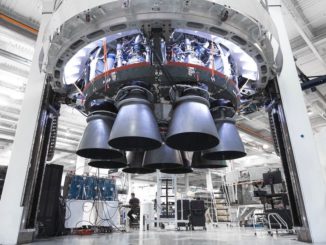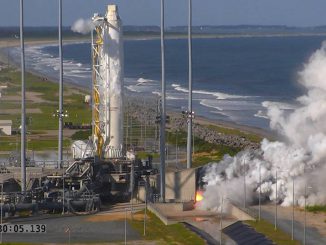
CAPE CANAVERAL — Two space shuttle solid rocket boosters — reusable space hardware that launched on 81 missions — are being gifted to the California Science Center to become part of the museum’s launch pad display of Endeavour.
Made by Orbital ATK, the twin boosters provided the vast majority of the takeoff thrust for every shuttle flight from 1981 through 2011. They were the first stage of the shuttle launch stack.
Now, the company is donating two authentic flight motor sets to the California Science Center in Los Angeles to provide the structural support, seismic stability and authenticity in the Endeavour exhibit.
“We take great pride in our 30-plus years of participation in the Space Shuttle Program,” said Charlie Precourt, vice president and general manager of Orbital ATK’s Propulsion Systems Division. “We’re pleased and honored that we can contribute hardware to this amazing exhibit at the California Science Center.”
The flight history of the segments spans STS-5 in 1982 to STS-133 in 2011.

The decommissioned Endeavour orbiter was flown to the educational facility in 2012 and NASA donated the last remaining flight-quality external fuel tank last year. The boosters will complete the real-life display of a space shuttle in its launch configuration as if standing on the pad.
All three phases of flight are represented by the three surviving, space-flown orbiters on public display: Atlantis at Kennedy Space Center with payload bay doors open to depict an in-space theme and Discovery at the Smithsonian resting on its landing gear as if just landed.
Endeavour will be standing in launch position, mated to the tank and boosters, with public viewing angles all around the vehicle.
Construction of the Samuel Oschin Air and Space Center that will showcase the vertical shuttle indoors, to be built adjacent to the California Science Center and near to the LA Memorial Coliseum, is supposed to begin this summer for a grand opening in 2019.
Orbital ATK says the request for donated booster segments was made by Dennis Jenkins, the Samuel Oschin Air and Space Center project director.
“As for the non-motor parts of the booster, we sourced a set of flight-worthy aft skirts and frustums from NASA surplus and a set of forward skirts that were used for tests for NASA’s Space Launch System (SLS) Program that are currently in Utah at Orbital ATK,” said Jenkins. “Orbital ATK and NASA are providing most of the smaller parts, like booster separation motors, from surplus.”
The booster casings headed to the California Science Center have flown on 81 space shuttle flights and have been part of 32 ground tests.

Schedules for moving the booster pieces from Utah to California are pending completion of the private fundraising needed.
Each reusable solid was produced in Utah, shipped by rail in segments to the Kennedy Space Center where technicians stacked them together aboard a mobile launch platform inside the Vehicle Assembly Building.
Delivering a combined 6.6 million pounds of thrust, they burned for two minutes and four seconds before separating, deploying parachutes and splashing down in the Atlantic for recovery.
They were towed ashore, the segments disassembled and shipped back to Utah to be refilled with propellant and readied for another mission.
Each booster stands 149 feet high and 12 feet wide. They were filled with a million pounds of propellant, a cured fuel similar to a hard rubber eraser, made of powdered aluminum mixed with ammonium perchlorate.
The California Science Center is known for its hands-on educational experience for schoolchildren and hosting class field trips. Endeavour has been an inspirational tool at the institution, encouraging kids to study science, technology, engineering and math since going on display four years ago.
Today, the public can see the spaceplane and walk underneath the veteran spaceplane for free in a pavilion near the site of the future museum.
Other items currently displayed separately include Endeavour’s galley and toilet, the tires from her final landing, a fuel cell and real space shuttle main engine.
The California Science Center also houses three space capsules — Mercury 2 that launched the chimpanzee named Ham in 1961, Gemini 11 flown by Pete Conrad and Dick Gordon in 1966 and the U.S. command module from the 1975 Apollo-Soyuz Test Project that featured the first handshakes in space between Americans and the Soviets.
Endeavour flew 25 missions in space, orbited the Earth 4,677 times and accumulated 299 days in spaceflight over a 19-year flying career.



